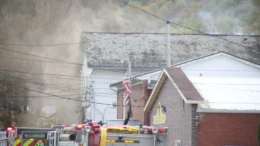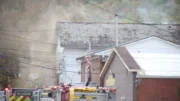WASHINGTON (AP) — On a clear, dry June evening in 2015, cars and trucks rolled slowly in a herky-jerky backup ahead of an Interstate 75 construction zone in Chattanooga, Tennessee. Barreling toward them: an 18-ton tractor-trailer going about 80 mph.
Despite multiple signs warning of slow traffic, the driver, with little or no braking, bashed into eight vehicles before coming to a stop about 1½ football fields away. Six people died in the mangled wreck and four more were hurt. The driver was convicted of vehicular homicide and other charges last month.
In response to this and similar crashes, the government in 2016 proposed requiring that new heavy trucks have potentially life-saving software that would electronically limit speeds. But now, like many other safety rules in the works before President Donald Trump took office, it has been delayed indefinitely by the Transportation Department as part of a sweeping retreat from regulations that the president says slow the economy.
An Associated Press review of the department’s rulemaking activities in Trump’s first year in office shows at least a dozen safety rules that were under development or already adopted have been repealed, withdrawn, delayed or put on the back burner. In most cases, those rules are opposed by powerful industries. And the political appointees running the agencies that write the rules often come from the industries they regulate.
Meanwhile, there have been no significant new safety rules adopted over the same period.
The sidelined rules would have, among other things, required states to conduct annual inspections of commercial bus operators, railroads to operate trains with at least two crew members and automakers to equip future cars and light trucks with vehicle-to-vehicle communications to prevent collisions. Many of the rules were prompted by tragic events.
“These rules have been written in blood,” said John Risch, national legislative director for the International Association of Sheet Metal, Air, Rail and Transportation Workers. “But we’re in a new era now of little-to-no new regulations no matter how beneficial they might be. The focus is what can we repeal and rescind.”
Trump has made reducing regulations a priority, seeing many rules as an unnecessary burden on industry. Last month he tweeted that his administration “has terminated more UNNECESSARY Regulations, in just 12 months, than any other Administration has terminated during their full term in office…”
“The good news is,” he wrote, “THERE IS MUCH MORE TO COME!”
The Transportation Department declined repeated AP requests since November for an on-the-record interview with Secretary Elaine Chao, Deputy Secretary Jeffrey Rosen or another official to discuss safety regulations. Instead, the department provided a brief statement from James Owens, DOT’s deputy general counsel, saying that new administrations typically take a “fresh look” at regulations, including those that are the most costly.
The department’s position has been that it can reduce regulation without undermining safety. And DOT officials have questioned whether some safety regulations actually improve safety.
“We will not finalize a rule simply because it has advanced through preliminary steps,” the statement said. “Even if a rule is ‘one step away,’ if that rule is not justifiable because it harms safety and imposes unnecessarily high economic costs, for example, that rule will not advance.”
But the rule requiring new trucks to have speed-limiting software would actually have economic benefits, according to a DOT estimate prepared two years ago. It would save as many as 498 lives per year and produce a net cost savings to society of $475 million to nearly $5 billion annually depending on the top speed the government picked. That’s nearly half the 1,100 deaths annually in crashes involving heavy trucks on roads with speed limits of 55 mph or higher. The government didn’t propose a top speed but said it had studied 60, 65 and 68 mph.
The proposal was also expected to solve another problem: Most heavy truck tires aren’t designed to travel over 75 mph, but some states have 80 mph speed limits.
Rick Watts of Morristown, Tennessee, who lost his wife, two young step-daughters and mother-in-law in the I-75 crash, said he can’t understand why the proposal has been sidetracked.
“If you’re going 80 and you’re knocked down to 60, that’s going to lower the impact,” he said. “It just stuns me that you can give these people proof and they say, ‘We’ll look into that.’ It just baffles me that they’re killing so many people every year.”
The American Trucking Associations, an industry trade group, has claimed credit for stalling the rule. After initially supporting it, the group now says it would create dangerous speed differentials between cars and trucks. A news release from the associations said its success in stalling the rule is a significant triumph for the industry.
The trucking industry has developed a strong relationship with Trump. Trucking officials met with Chao within hours after she took office, according to Chris Spear, the trade group’s president. Trump welcomed trucking executives to the White House by climbing behind the wheel of a Mack truck parked on the South Lawn in March.
“Your story is now being told to the highest levels of government,” Spear told his organization’s members in October.
DOT’s position on the speed-limiting software is that it isn’t dead but that the department has limited resources and higher priorities. No action is expected before the end of the federal fiscal year on Sept. 30 at the earliest.
Some rules that were in the works have been abandoned entirely. After four people died when a New York commuter train derailed while speeding around a curve in 2013, investigators determined that the engineer had fallen asleep. He had undiagnosed sleep apnea, a disorder that causes pauses in breathing and prevents restful sleep, and had made no effort to stop the train.
The National Transportation Safety Board blamed the crash in part on federal regulators for not requiring medical screening of engineers for sleep disorders. Yet last summer, DOT withdrew a rule the government was in the early stages of writing to require screening for engineers and truck and bus drivers.
The government said current safety programs either address the problem or it will be addressed in a rulemaking to reduce fatigue risks in the railroad industry. But the fatigue rule is years overdue with no timetable for completion.
The NTSB has cited sleep apnea as a cause of 13 rail and highway accidents it has investigated, including two more commuter train crashes in Hoboken, New Jersey, in 2016, and Brooklyn, New York, in 2017.
“Looking at the multiple piles of broken sheet metal and broken engines and broken people, (DOT’s strategy) doesn’t seem to have been effective,” Dr. Nicholas Webster, an NTSB medical officer, told a recent public meeting on the crashes.
But Dan Bosch, regulatory policy director at the conservative American Action Forum, said the Trump administration is “actually taking a very reasoned and measured approach to how they’re de-regulating.”
Most regulations Trump has taken credit for blocking throughout the government were Obama administration proposals that were on track to be adopted but had yet to be finalized, or that weren’t being actively pursued — “low-hanging fruit,” Bosch said.
There is a longstanding requirement that major federal regulations undergo detailed cost-benefit analyses before they can become final. Even rules expected to save lives are weighed against their economic cost. DOT assigns a value of $9.6 million per life saved in its analyses.
Trump has ordered that two regulations be identified for elimination for every significant new regulation issued. The White House has acknowledged its calculations of savings from rolled-back regulations cited in public statements include only the cost to industry and others without taking into account benefits the rules produce, including lives saved.
Rosen, the deputy secretary, heads DOT’s task force that evaluates regulations for repeal or modification. In extensive written and public comments before joining the administration, he criticized regulations as an indirect tax on industry, but made little mention of their benefits. He has called for curbing federal agencies’ regulatory power by imposing greater analytical requirements and requiring congressional approval before more costly regulations become law. Rosen has also advocated making it easier for industry to challenge regulations in court.
Rosen is an attorney who formerly represented General Motors and an airline industry trade group. Other DOT political appointees with strong ties to the industries they regulate include:
—Daniel Elwell, the acting administrator at the Federal Aviation Administration, who is a former airline lobbyist.
—Cathy Gautreaux, deputy administrator at the Federal Motor Carrier Safety Administration, which regulates the trucking industry, spent 29 years as executive director of the Louisiana Motor Transport Association, a trucking advocacy group.
—Ron Batory, the head the Federal Railroad Administration, was president of Conrail, a service provider for the CSX and Norfolk Southern freight railroads.
—Howard Elliott, head of the Pipeline and Hazardous Materials Safety Administration, is a former CSX executive. Among other things, his agency sets safety rules for rail transport of hazardous goods, including crude oil, ethanol and toxic chemicals.
Industry’s influence on regulations generally “is probably more powerful than it has ever been,” said Neil Eisner, who was the DOT assistant general counsel in charge of overseeing the issuing of regulations for more than three decades.
DOT says having industry insiders in leadership positions provides deep practical experience in how the transportation industry works.
In October, DOT published a notice inviting the public to recommend which regulations should be repealed, replaced, suspended, or modified. Accompanying the notice was a list of 20 potential candidates, including 13 of the most significant transportation safety rules of the past decade.
Airlines, automakers, railroads, pipeline operators, trucking companies, chemical manufacturers and others responded to the notice with their wish lists. After the comment period closed, DOT said it would repeal a 2015 rule opposed by freight railroads requiring trains that haul highly flammable crude oil be fitted with advanced braking systems that stop all rail cars simultaneously instead of conventional brakes that stop cars one after the other.
The advanced brakes can reduce the distance and time needed for a train to stop and keep more tank cars on the track in the event of a derailment, DOT said two years ago when it issued the rule.
Freight railroads, which say the rule’s safety benefits are marginal and don’t justify the cost, persuaded Congress to require DOT to revisit the rule. The department now says its revised analysis shows costs would outstrip benefits.
The advanced brakes perform significantly better than conventional brakes alone, but only slightly better in emergency braking situations when trains have locomotives in both the front and the back, said Risch, the union official. But trains aren’t required to have two locomotives and often don’t, he said.
The advanced brakes also have significant safety benefits DOT didn’t consider, Risch said, including the ability to prevent runaway trains like the improperly secured oil train that derailed in Lac Megantic, Canada, in 2013, igniting a fire that killed 47 people. The advanced brakes are already required for trains that haul radioactive waste.
The rule’s repeal, said Risch, a former engineer who has operated trains with advanced brakes, means the government is abandoning “the greatest safety advancement I’ve witnessed in my 41 years in the industry.”
———
Follow Joan Lowy on Twitter at @AP—Joan—Lowy and @tkrisher









































